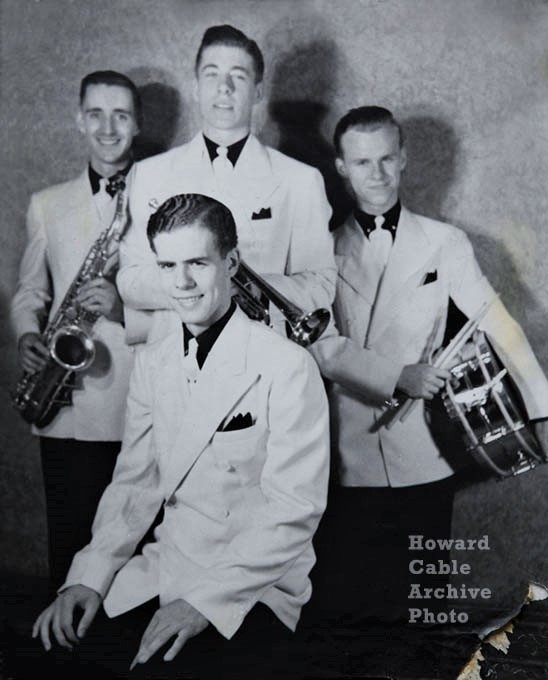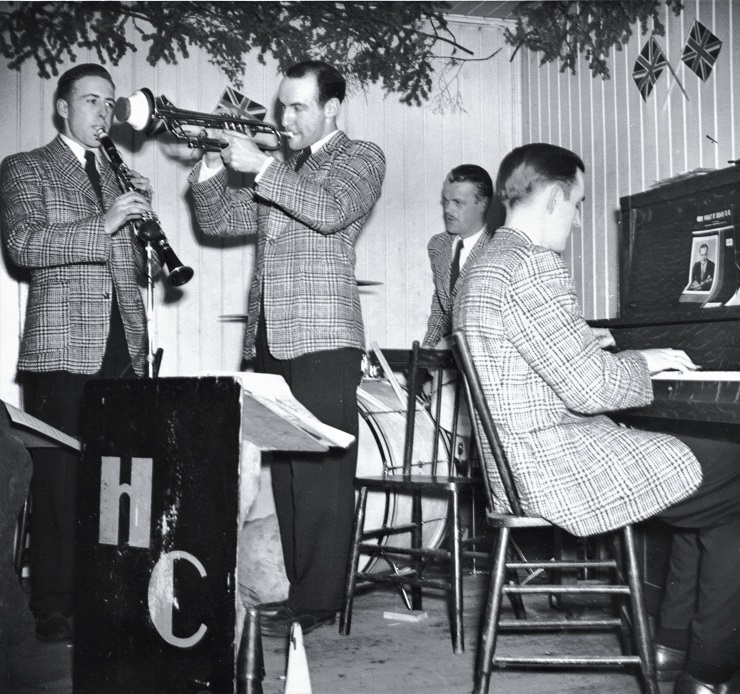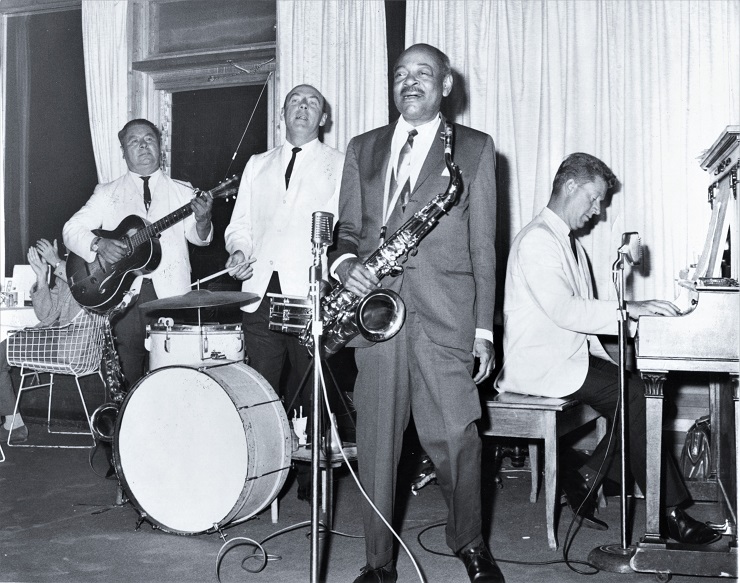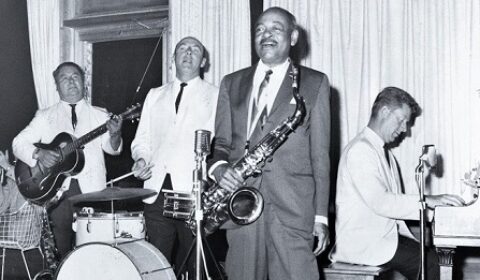SONGS OF MUSKOKA AND MORE WANDERLUST … OR WHAT YOU WON’T FIND ON SPOTIFY
STEPHEN RICHARDS | Guest columnist FICTION
Bart’s apartment, basement of Musician’s Friend, 2012
Bart is dreaming ….
1675 — The trade war with the Dutch had just ended. The British achieved maritime supremacy and exploration seeking out white pine for shipbuilding and beaver pelts for the latest fashions.
Hutch Nielsen and Robert Jefferson, employed by the Hudson’s Bay Company, are scoping out this area and just scribed the year on a stone marker while swatting at swarms of black flies. They thrash through the brush to the narrows on the shore of a lake between some cedars. Robert pulls out a telescope observing some men in fully-laden birch bark canoes fighting against the strong winds blowing around a large island as they head Due North. After noting his observations in a journal, Hutch and Robert press on north and west.
1812 — The territory, which derived its name from an Indigenous hero “Mesqua-Ukee,” gained importance as a strategic point to defend against the southern aggressors. Permanent residence of this region only came after the free land grants happened many years later.
March 1857 — Francis, a lean man, 36, full head of long hair tied back with a leather strip, corded muscles, large calloused hands accustomed to hard labour, is chopping wood around Trading Lake. He is building his log home in Cedar Narrows (where the tips of cedar branches met over a channel connecting two bodies of water).
He wipes sweat and wood chips off his brow. His friend, Joseph, approaches, dropping his bundle of trade goods, and passes him a smoke. They sit on log stumps making small talk. Joseph taught him many things: respect Mother Earth, forage, nothing goes to waste, snowshoes, birch bark canoe, tan leather, maple syrup.
Francis earned Joseph’s trust and engaged in mutually profitable trade. Francis starts a fire, roasts some venison on a spit. Francis grabs the jug and doles out Spruce Beer brought over from Rigaud, Quebec. He places the dented and misshapen fry pan over the fire, cooks his special recipe of high hydration sourdough batter, sprinkles maple sugar on it, and passes the cake-like treat to Joseph on a dried beaver tail platter.
. . .
June 1920 — A magnificent hotel with a unique octagonal dining room and matching pavilion is completed. Images of a Rotunda, Grand Hall, Tea House and four stone cottages flash in his mind. Five-hundred guests are present and Anglo Canadian Concert Band is playing.
Summer, 1943 — A young girl is twirling around dancing in her orange tulip print dress in a magnificent pavilion. A ‘B’ is embroidered above her heart.
Desmond, a puffy Maine Coon Cat pounces onto Bart’s belly, before returning to his hassock and observing Bart bolt upright and exhale an “Ooof’ of air.
It’s 7:30 a.m. Bart’s oPhone is glowing — a text message has arrived. With a puzzled expression, he glances at Desmond. Desmond examines a nail on one of his toes and nonchalantly points at Bart’s phone. Bart picks up his phone and looks at the screen. There’s a message from Claire Mont-Marque, affectionately known as “e-Claire.”
“We gotta meet. Now!”
Bart sets out Desmond’s breakfast, pours himself a glass of Sunny D, doles out a bowl of Shreddies with skim milk and chows down. Bart runs upstairs to the sales desk, leaving Marley Kim, his boss, a note: “Gonna be late. Will explain later. Bart”
He climbs into his robin-egg blue Gremlin-Pacer. Desmond jumps in beside him with a creak and together they head over to the Opera House to find e-Claire in his office hunched over a brochure.

Gravenhurst Opera House
“Why do you call me ‘e-Claire?’ Mont-Marque asks, as he munches on peach Tompouce (a traditional Dutch pastry consisting of a thin puff pastry that is filled with cream and topped with a layer of smooth, fruit flavored icing).
“Ha, ha, ha!” Bart chuckles “Umm — because you’re so wired into the music community. So what’s up?”
“I got a call from Howard Reid,” says Mont-Marque, who is working on arranging the music for Drayton’s 2012 show ‘Big Band Legends.’ And he wants us to locate some original pieces he wrote and misplaced back in the 1940s when he had some gigs up north of here early in his career.”
He turns his laptop around: “Check out this YouTube ….
“In a 2012 interview with The Record, Howard reminisced about the heyday of big band music, the 1930s and 1940s (he was rejected from serving during the Second World War because of poor eyesight). Howard’s parents paid for piano lessons. When a high school teacher started a band, he decided to join. But could he please play the clarinet instead of piano? He bought a clarinet and taught himself to play.
“There was no music in high school in those days,” Howard recalled. “I became good enough that eventually I traded the clarinet for an oboe.”
Even in high school, Howard was well on his way musically and was given a scholarship to study conducting and band mastership at the Royal Conservatory of Music, graduating in 1939. He led a dance band from 1935-1943 in various summer resorts in cottage country.
A longtime relationship with the Canadian Brass is his claim to fame. In 1999, Howard was made a member of the Order of Canada in recognition of his legendary contribution to the Canadian Music Industry.
“These pieces have never been published? Maybe we will be able to play them up here!” Bart asks. “So what is that brochure you are looking at?”
“It’s a walking tour of Dorset highlighting some of the sites,” responds Mont-Marque. “I figure if we check them out we might be able to get some clues. It was written by Alfred ‘Crowbar’ Jones. I will contact him to set up an appointment this weekend. Does that sound like a plan?”
Musicians Friend, an hour after opening
Bart makes it back to Musicians Friend with two Northern Dark coffees from Oliver’s and hands one to Marley, who is reading the note. “Ta. So what’s up?”
“Have you ever heard of Howard Reid?”
“Of course. He was born December 15, 1920 in Toronto. Studied piano, clarinet and oboe. Was a composer, arranger, and conductor. Back in the 1940s, I believe, he had a band called the ‘Cavaliers’ and a number of his early arrangements bore strong Ellington influences. Each new arrangement was like a discovery. A touch of the Duke’s ‘Jumpin’ Pumkins’ and ‘Jack The Bear,’ and a whiff of Charlie Barnet’s ‘Cherokee’. This hands-on experimenting helped him become the arranger he wanted to be and he spent that whole time writing. I think the Cavaliers got a booking at various dance halls in Muskoka.”
“I plan to go to Dorset with e-Claire. Maybe you can give Howard a follow-up call to get some more info. We need to track down some pieces he misplaced up here.”

That weekend in Dorset
A song is heard in the distance as a vehicle approaches:
“Well you, we got the feelin’, makes you come alive.
We’re gonna boogie woogie, we’re gonna rock and roll, we’re gonna jive.
We’re gonna make you loose, go where you have to go
Gonna fill your head with music, satisfy your soul.
Oh what a feelin’, what a rush”
Alfred parks his meticulous 2000 Plymouth forest-green voyager van, deluxe with wood panel trim, dog dish hub caps, roof racks and a triple-ball trailer hitch. He’s very handy and can fix anything. A lean man, clean-shaven head, full beard, bush jacket vest and large calloused hands accustomed to hard labour. He just donated his hair to charity hence his slick scalp. Normally his hair would be long, pulled back and secured with a leather cord. The man apparently owns and maintains many properties in addition to his Dorset home. The oldest and his only one in Quebec is in Rigaud; the others around Ontario including Prescott, Peterborough, Oxtongue Lake and Manitoulin Island.
Alfred and Mont-Claire talk about the history of the area, primarily about the conducts of Francis Harvey between 1821 and 1903.
“He had wanderlust. Born in Rigaud, Quebec. Paddled 156 km down St. Lawrence and married Ellen Smith. Left her on his farm in Prescott, Ontario,” says Alfred. “Canoed through the lake system. Claimed land in Peterborough and continued on.
“In 1854, he became the first permanent settler in and around Cedar Narrows, what is now called Dorset (renamed in 1892, after the town in England that Mrs. Dollars’ prized Lilacs came from). Established a trading post, trapped and hunted, fished, farmed potatoes, foraged foodstuffs to survive, including berries, mushrooms, garlic, onions and rhubarb. Also raised dairy cattle and chickens.
“Brought back crops from his Prescott farm, by ox cart, along what is now Highway 60. He cleared trails throughout the area from Lake of Bays (a.k.a. Trading Lake or Lake of Many Forks), established a wharf in 1885 at the narrows, and built the original bridge across narrows to support trade. His original log home built in 1857 was expanded many times. Then in 1882, he built his second home on the shore (square timber, dove-tail construction). The original plank floors, high ceilings and windows remain to this day. Business was good. Harvey Avenue, Harvey Lake and Harvey Lake Jr.. are named after him.”
Alfred continues explaining that Francis would paddle 10 miles across Lake of Bays, portage to Penn Lake then on to Fairy Lake hauling trade goods to Huntsville.
With the 1868 land grant, settlers came to the surrounding area. Francis shared his Beaver Tail treat recipe with the Hooper Family, the secret of Birch Bark Canoe construction with the Langenford’s and snow shoes assembly with the Solomons. He mapped out the trucking routes to the Bartleby’s, provided Shaw with his ‘Acadian’ Leather tanning method and eventually gave to Ed Speers his trading operation that outfitted tourists with high boots, fur coats, woolen pants and socks. That’s because visitors often showed up ridiculously attired in swallow tailcoats, silk hats, tinted gloves and buckled shoes. All totally inappropriate for these conditions.
“Oh yeah … and Ed sold them plenty of fudge,” added Alfred.
“Downsizing his operation allowed Francis more time to fiddle and call at square dances in the hotels, dance halls, the Big Wind Island Gazebo and various places around Huntsville and Bracebridge.”
“Wow. He was quite the guy. Lead on, sir,” says Bart.
Bart and e-Claire then follow Alfred on the tour.

Back at Marley’s apartment
Marley just got off a call with Howard Reid to get some answers. Howard provides some background, which Marley now relays to Bart in this call.
“In 1943, I take it they got a booking at various dance halls in Muskoka and began looking for a trumpet and piano player and horn and reed players. Four nights a week, for a salary of $12 per week, plus room and board. The band, which was originally a pick-up group, initially played mostly stock arrangements — and did so quite well. I think they most likely got the job because of business connections, rather than musicianship. But over time they improved and then wrote and played their own compositions. One ballroom, complete with balcony overlooking the lake, occupied the entire second floor of a pavilion and was packed with an appreciative audience.
“Their lodging, he recalls, was up on the hillside a fair distance from the hotel. There was a very distinct separation between the status of the patrons and that of the employees. And they were quickly informed of the “rules of the establishment.” The hotel’s front grounds and lobby were for the guests only. Musicians were on the same social tier as maids and kitchen staff, and as such the only access was through the back door. They were also required to walk the back path down to work, rather than the shorter route down the front.”
While the hotel catered to tourists, the ballroom was frequented by the wealthy from the surrounding area. They would arrive in style — often by boat. He remembers watching from the balcony as the beautiful Muskoka cruisers pulled up one by one to the docks. They were magnificent hand-crafted powerboats finished in gleaming mahogany. To his surprise, almost all were chauffeur-driven. The men with the caps would wait sometimes three hours, like livery people used to do, for their employers to have their fill of alcohol and dancing, then cruise them back to their cottage estates.
All in all, this dance gig provided a great opportunity for all the members of the band. Not only were these teenagers being put up in a resort, but they got to play dances in beautiful Muskoka all summer long. They played mostly four nights a week, and had the rest of the time for themselves. Apparently, Fred spent his free time socializing, while the other guys did the typical things that teenage boys do while away from adult supervision.
“And Howard? He said he sat on the upper balcony writing arrangements, going on bike rides, touring the grounds, sailing a Wayfarer.
“He remembers a little girl in an orange dress with a tulip print dancing around. She was sad. And lonely.
“Then there was a Lois ‘Moneypenny’ Maxwell. The name is oddly familiar, but can’t place it. She was a waitress in the tea room. And was quite sweet, but mysterious. He also recollected she was fond of gadgets, and virgin martinis — shaken, not stirred.
“And finally, he had pleasant memories listening to the three ‘Lovely Good’ Dragons among the whispering evergreens on Boshkung Lake Road near the Mason family’s homestead.”
Bart thanks her.
“That gives me some ideas. I will run it by Alfred and we will see where that goes. In the meantime, can you do some research on hotels and dance halls in the area? Talk to you later.”
To be continued ….
Steve Richards is a Muskoka musician who longs to play local outdoor festivals and venues once the pandemic calms down.

February 2, 2022 @ 1:19 pm
Loved this guest column — great blend of fact and fiction…